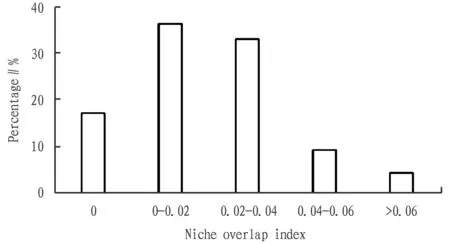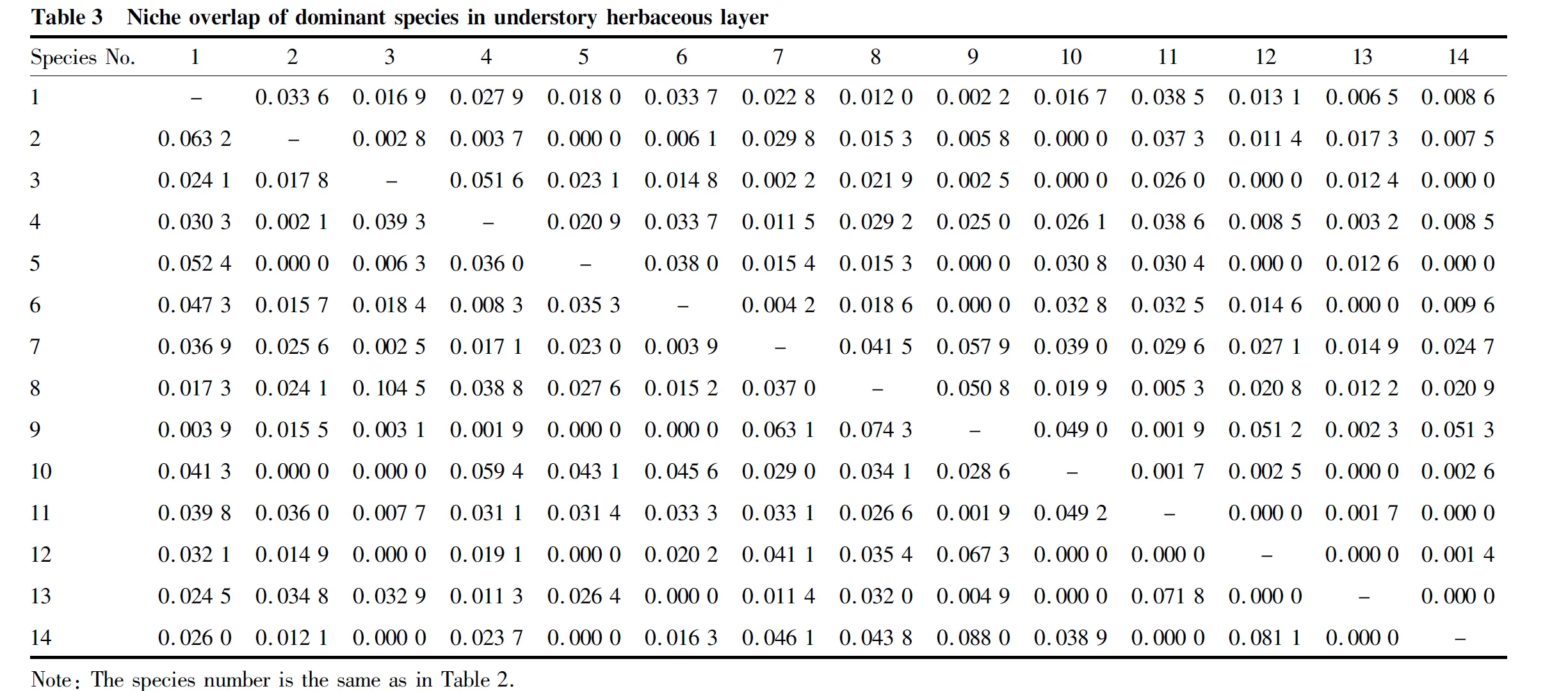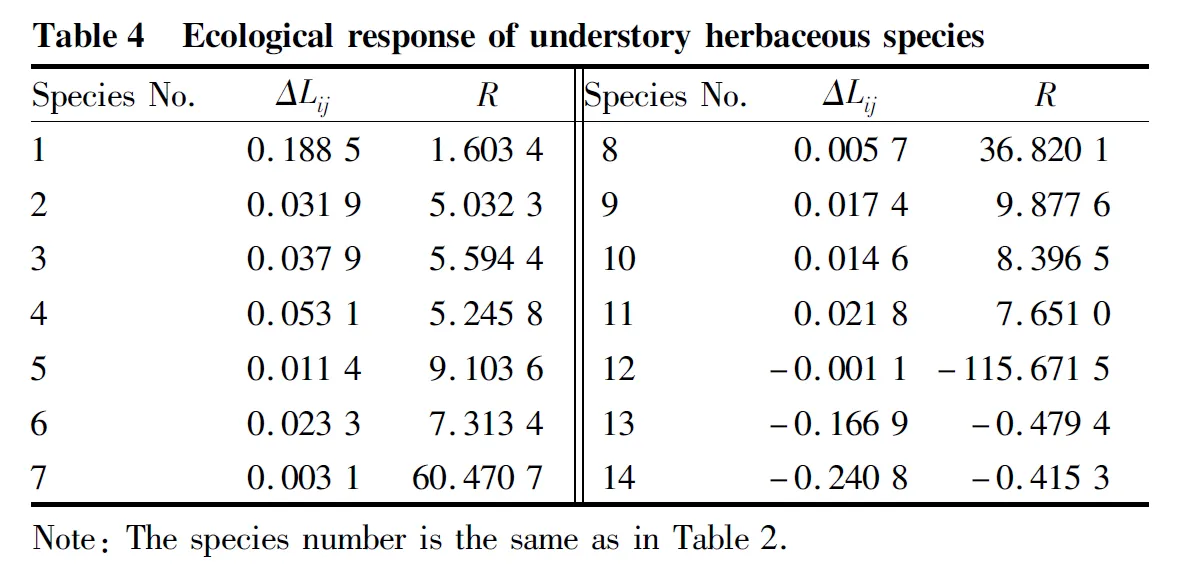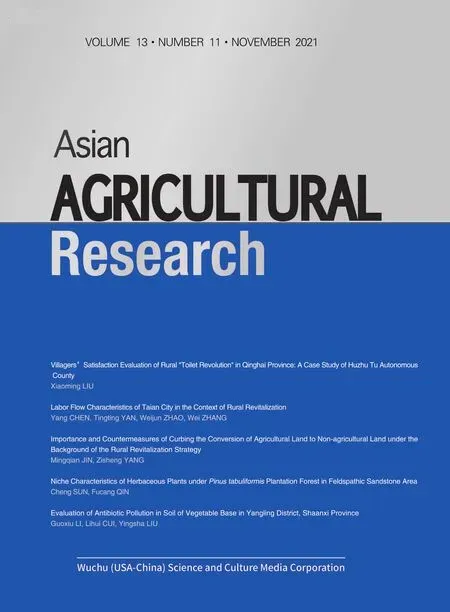Niche Characteristics of Herbaceous Plants under Pinus tabuliformis Plantation Forest in Feldspathic Sandstone Area
Cheng SUN, Fucang QIN
Key Laboratory of State Forest and Grassland Administration for Desert Ecosystem Protection and Restoration, Hohhot 010018, China
Abstract [Objectives] To explore the niche characteristics of herbaceous plants under Pinus tabuliformis plantation forest in the feldspathic sandstone area, and to provide basic data for maintaining biodiversity and community stability in the local P. tabuliformis plantation forest. [Methods] The types, quantity, average plant height, and coverage of various herbaceous plants were recorded by field survey in a well-growing P. tabulaeformis forest area. Based on the survey data, Shannon and Levins niche breadth index, Levins niche overlap index and ecological response were used to analyze the niche characteristics of herbaceous plants under P. tabulaeformis plantation forest. [Results] (i) There were 35 species of herbaceous plants in the P. tabulaeformis plantation forest in the feldspathic sandstone area. Among them, Stipa bungeiensis had the largest niche breadth indexes with better performance. Because of its strong adaptability, its community was in an obviously advantageous position. (ii) The overall niche width and niche overlap index were generally not high, and understory herb species showed differentiation. (iii) Among the understory herbaceous species, 37.15% of the species were developed species, and 62.86% of the species were declining species. Among the 14 dominant species, 11 were developmental species. The species with largest the resource occupancy were S. bungeiensis (0.188 5), Heteropappus altaicus (0.053 1), and Cleistogenes squarrosa (0.037 9). [Conclusions] Competition among under herbaceous plants in P. tabulaeformis plantation forest in the feldspathic sandstone area was weak, and the community species had poor utilization of resources and environment. Most of the dominant herbaceous species were in the developing stage, indicating that the P. tabulaeformis plantation community tends to be relatively stable at the current stage.
Key words Feldspathic sandstone, Plantation, Niche, Ecological response, Herbaceous plants
1 Introduction
The concept of niche was first proposed by the ecologist Grinnell and used for the first time to express the status of biological units in environmental space units, namely, spatial niche. Later, the ecologist Hutchinson proposed a more modern n-dimensional niche theory from a multi-dimensional perspective. Nowadays, the two specific indicators of niche width and niche overlap are commonly used to conduct objective evaluation and research on the niche of a certain species community. Its principle is as follows: the niche width can reflect the range of the dominance of the species community over environmental resources, while the niche overlap is mainly the specific quantification of the overlapping use of environmental resources by related species. Through analysis of these two indicators, it is able to explore the status of competition and coexistence between species. With the continuous development and evolution of the niche theory, it has received much attention in the field of ecology, and is mostly used to study the coupling relationship between species in natural communities and between communities and the environment.
Understory vegetation, as an important part of the plantation forest ecosystem, plays an important role in maintaining species diversity and ecosystem stability. Revealing the composition, structure and coexistence of understory species in plantation forests is an important method to evaluate the ecological functions of plantation forests and judge the restoration of ecological functions. Niche research is a main means to solve the coexistence and mutual adaptation of herbaceous plants under plantation forests. It is of important theoretical and practical significance for evaluating the growth and development characteristics, interspecific relationships and functional status of the population in the community of herbaceous plants under plantations, and for promoting plantation species diversity and restoration of ecological functions.
The feldspathic sandstone area is one of the most severely eroded, sand-producing, and soil erosion areas in China. The unique diagenesis mechanism of feldspathic sandstone makes it extremely vulnerable to denudation under the interaction of hydraulic and wind power, and ecological restoration is extremely difficult. Since the 1980s, China has started ecological management and continued to build plantations. Now, local vegetation in the feldspathic sandstone area has been restored, soil erosion has been controlled, and the ecological environment has obtained significant improvement. At present, there have rich achievements both at home and abroad in plantation forest management in the feldspathic sandstone area. Chen Penget
al.
studied the ecological stoichiometric distribution characteristics of the soil in the feldspathic sandstone area and the ecological response to the measures of returning farmland to forest in this area, providing a basis for ecological restoration and forest management measures. Yang Zhenqiet
al.
surveyed the diversity and conducted an environmental interpretation of understory herbaceous species inHippophae
rhamnoides
plantation forests, and explored the relationship between understory herbaceous species diversity and the environment. Wu Xiaoguangand Yuan Qinet
al.
studied the relationship between the main plantation species and the physical and chemical properties of the soil in the feldspathic sandstone area, to elaborate the functions of plantation forests in improving water and soil in the feldspathic sandstone area. However, there are few studies on the maintenance of species diversity and ecological stability of plantation forests in the feldspathic sandstone area.P.
tabulaeformis
is the main tree species for plantation in the feldspathic sandstone area. It is an excellent afforestation coniferous tree. Due to the advantages of strong adaptability, rapid growth, and developed root system,P.
tabulaeformis
plays an important role in conserving water and soil, conserving water resources, and forestry production. Most studies of theP.
tabulaeformis
plantation community focuses on the abundance, uniformity and diversity index of the understory herbaceous plant communities, while few studies concern the ecological status, functional structure and inter-specific coexistence and competition of understory herbaceous plant communities. In view of these, using the niche theory to quantify the niche width and niche overlap index, we analyzed the characteristics of the main understory herbaceous communities of theP.
tabulaeformis
forest, to find out the status of various species in the understory herbaceous community and the current situations of the use of environmental resources, and explore the internal development rules of understory herbaceous organisms, so as to provide a scientific basis for in-depth study of the community structure and stabile and sustainable development ofP.
tabulaeformis
.2 Study area and methods
2.1 Overview of the study area
The study area is located in the Baojiagou Watershed (110°31′-110°35′ E, 39°46′-39°48′ N) in the soil and water conservation demonstration park in the feldspathic sandstone area of Jungar Banner, Ordos City, Inner Mongolia Autonomous Region. The terrain of this watershed slopes from north to south, with an altitude of 1 100-1 300 m. Its climate belongs to the temperate semi-arid continental climate, with dry and long winter and warm and short summer. The average annual temperature is 7.2 ℃, the average annual rainfall is 400 mm, and the frost-free period is about 150 d. The soil types are mainly chestnut soil and aeolian sandy soil. TheP.
tabulaeformis
plantation plot in the study area was planted in the same batch in 2008. The existing stand density was 833 trees/ha, the average tree height was 2.73 m, and the average crown width was 2.19 m. The shrubs in the study area were mainlyH.
rhamnoides
andCaragana
korshinskii
, and herbaceous plants were mainlyStipa
bungeana
,Thymus
mongolicus
,Cleistogenes
squarrosa
, andHeteropappus
altaicus
,etc.
2.2 Study methods
2.2.1
Plot setting and data collection. After the field surveys, based on the topography of the watershed and the distribution characteristics of the plantation forests, we selected threeP.
tabulaeformis
forests with good growth and basically the same altitude, slope, and aspect as the research objects in July 2019. The basic information of each plot was shown in Table 1. At the four corners and the center of each ofP.
tabulaeformis
plantation forest, we set a total of 5 large plots of 10 m × 10 m, surveyed and recorded the number of trees, tree height, crown width, and canopy closure in each plot, and recorded the altitude, aspect, and slope of the each plot. In each large plot, we selected three 1 m × 1 m herbaceous plant plot in the upper right corner, lower left corner and the center according to the diagonal method, and surveyed and recorded the types and numbers of herbaceous species, average plant height and coverage.
2.2.2
Importance value. It is a comprehensive quantitative indicator reflecting the role and status of a species in the communityand can be calculated by the following formula:Importance value=(Relative coverage+Relative height+Relative density)/3
where Relative coverage=(Coverage of a certain plant in the plot/Sum of the coverage of all plant species in the plot)×100%; Relative height=(Average height of a certain plant in the plot/Sum of the average height of all plant species in the plot)× 100%; Relative density=(Number of individuals of a certain plant in the plot/Number of individuals of all plant species in the plot)×100%.
2.2.3
Niche width. The niche width is calculated by Shannon-Wiener and Levins:
(1)

(2)

(3)
whereB
()is the Shannon-Wiener niche breadth index of speciesi
, the value range is [0,lnr
];B
()is the Levins niche breadth index of speciesi
, the value range is [1/r
,1];P
is the ratio of the importance value of speciesi
at thej
resource position to the importance value of the species at the total resource level;n
is the importance value of speciesi
in thej
resource position;r
is the total number of resource positions (the number of plots in this study).2.2.4
Niche overlap. It uses the Levins Niche overlap index and can be calculated by the following formula:
(4)

(5)
whereL
denotes the overlap index of speciesi
to speciesh
,L
denotes the overlap index of speciesh
to speciesi
, the value range of both is [0, 1];P
is the ratio of the importance value of the speciesh
at thej
resource position to the importance value of the species at the total resource level;B
()is the Levins niche breadth index of the speciesh
;B
()is the Levins niche breadth index of the speciesi
.
R
=B
()/ΔL
(i
=h
)(6)
3 Results and analysis
3.1 Niche breadth of dominant species in understory herbaceous layer
Through the plot survey, we found a total of 35 plant species in the herbaceous layer underP.
tabuliformis
plantation forest in the feldspathic sandstone area. Among the surveyed species, the species with aB
()ecological breadth index less than 2 accounted for 77.14%, and 45.71% of the species had a niche breadth index less than 1, while 62.86% of the species had aB
()niche breadth index less than 0.1. According to the importance value, we screened out 14 dominant herbaceous species, among which theB
()andB
()ecological breadth indexes ofStipa
bungeana
,Thymus
mongolicus
Ronn,Cleistogenes
squarrosa
, andHeteropappus
altaicus
were greater. EspeciallyS.
bungeana
, both theB
()index (3.183 8) and theB
()(0.302 3) ranked first in the niche breadth of all herbaceous species. As indicated in Table 2, theB
()andB
()niche breadth indexes of most dominant species show a gradual decreasing trend, and their values were generally low, indicating that the overall niche of understory herbaceous species was narrow, the ability to control environmental resources was low, and population development was restricted. Through the analysis of resource niche, importance value and niche breadth in Table 2, the niche breadth has a certain relationship with the importance value of species. The niche breadths of species with high importance values are often large, but they are not in a single linear relationship with each other, and some species with low importance values have large niche breadths. However, species with a large niche breadth often have a large resource niche occupation. These indicate that the species niche breadth is related to the importance value of the species and the occupancy of the resource niche. For example,Gueldenstaedtia
stenophylla
, ranked 11, had an importance value of 0.12, and itsB
()niche breadth (2.056 4) and resource niche occupancy (24) were both high;Stipa
grandis
P.A. Smirn, ranked 5, had an importance value of 0.62, and itsB
()niche breadth (1.174 8) and resource niche occupancy (13) slightly fell behind.
3.2 Niche overlap of dominant species in understory herbaceous layer
As shown in Fig.1, the species with a niche overlap index of 0 in the herbaceous layer accounted for 17.03%, and the niche overlap index in[0,0.02),[0.02,0.04),[0.04,0.06), and [0.06,+∞) separately accounted for 36.26%, 32.97%, 9.34%, 4.4%, so the niche overlap index between species was generally small.
Fig.1 Distribution pattern of niche overlap index
According to the results of the niche overlap index (Table 3), the two species with the largest niche breadth,S.
bungeana
andH.
altaicus
had relatively high niche overlap with other major species. For example,S.
bungeana
andT.
mongolicus
Ronn (1-2) had the overlap of 0.063 2),S.
bungeana
andS.
grandis
P.A. Smirn (1-5) had the overlap of 0.0524,S.
bungeana
andG.
licentiana
(1-6) had overlap of 0.047 3,H.
altaicus
andC.
squarrosa
(4-3) had the overlap of 0.051 6,H.
altaicus
andA.
adsurgens
Pall. (4-8) had overlap of 0.0388, andH.
altaicus
andA.
argyi
Levl (4-10) had overlap of 0.059 4. A small number of species with smaller niche breadth show large niche overlap. For example,A.
melilotoides
Pall. andE.
gmelini
Turcz. (9-14) had overlap of 0.088 0, andA.
tenuissimum
L. andE.
gmelini
Turcz. (12-14) had overlap of 0.081 1. Comparing the same pair of species, we found that there is a significant difference in the relative niche overlap index. Such phenomenon is especially prominent in species with a large gap in niche width. For example, theL
ofS.
bungeana
toP.
linarifolia
Willd. was 0.024 5, while the Lhi ofP.
linarifolia
Willd. toS.
bungeana
was only 0.006 5. From the overall distribution pattern, the niche overlap index of the understory herbaceous layer species of theP.
tabulaeformis
plantation forest is generally low, and the similarity in the dominance of environmental resources among the herbaceous layer species is not high.
3.3 Ecological response of understory herbaceous species
Ecological response is the developmental or declining result of plants competing with each other under the comprehensive action of environmental resources. Among the 35 herbaceous plants surveyed, 37.15% of the species are developmental species, while 62.86% of the species are declining species. Among the 14 dominant species, 11 were developmental species and the species with largest the resource occupancy wereS.
bungeiensis
(0.188 5),H.
altaicus
(0.053 1), andC.
squarrosa
(0.037 9); 3 were declining species, namely,A.
tenuissimum
L.,P.
linarifolia
Willd., andE.
gmelini
Turcz.TheR
value reflects the ecological response rate of the species based on the ecological niche breadth. Among the 14 dominant herbaceous species surveyed, the species with the largerR
value wereL.
daurica
(Laxm.) Schindl. (R
=60.470 7) andA.
adsurgens
Pall. (R
=36.820 1), and the species with smallerR
value wasA.
tenuissimum
L. (R
=-115.671 5). From the distribution ofR
values (Table 4), among the dominant herbaceous species, exceptA.
tenuissimum
L.,P.
linarifolia
Willd., andE.
gmelini
Turcz., other species are developmental. With the continuous use of resources by developmental species, the environmental resources of declining species will be occupied, and their living space will gradually shrink or even disappear.
4 Discussion
The niche characteristics of species not only reflect the status and function of the community in the environment, but also reflect its ability to dominate environmental resources. The larger the niche breadth index, the stronger the adaptability of the species to the environment, the greater the dominance of environmental resources, and the easier it is to be in a dominant position in the environment and become a dominant community. In this study, the overall niche breadth of understory herbaceous species ofP.
tabulaeformis
plantation forest in the feldspathic sandstone area is generally small, only few heliophilous, cold-resistant and drought-tolerant species such asS.
bungeana
,H.
altaicus
, andC.
squarrosa
have a large niche breadth. These indicate that heliophilous cold-resistant species in the herbaceous layer under theP.
tabulaeformis
plantation forest in the feldspathic sandstone area are currently in a dominant position, which is closely related to the local habitat and species adaptability. On the one hand, the stand density ofP.
tabulaeformis
forest is small, the canopy closure is not large, and the phenomenon of sheltering the herbaceous plants is not obvious, so the heliophilous herbaceous plants take up a larger portion. On the other hand, the unique living environment of the feldspathic sandstone area forces the development of species with strong ecological adaptability, which leads to the poor biodiversity in the area.Niche overlap index reflects the common feature of different species’ dominance over the same type of environmental resources, and is an important indicator for judging the ecological similarity and competitiveness of species. Through this study, we found that the overall niche overlap index of the herbaceous layer species under theP.
tabulaeformis
plantation forest in the feldspathic sandstone area is not large. In general, a species with a wide distribution range and a higher importance value has a larger niche breadth and a greater niche overlap with other species. However, the niche overlap index among species with broad niches under theP.
tabulaeformis
plantation forest in this area is generally very low, which is possibly related to the discontinuous distribution of herbaceous species caused by the special geological conditions in the feldspathic sandstone area. It can also be seen that the competition among the dominant understory herbaceous species is not fierce, and the vegetation is relatively stable. For species with a niche overlap index of zero, their ecological habits and requirements for the use of environmental resources are completely different, and there is no competitive relationship with each other. In this study, we found that about 1/4 of the species had the niche overlap index of zero, indicating that the niche differentiation of the herbaceous community under theP.
tabulaeformis
plantation forest in this area is obvious, which is possibly related to the habitat heterogeneity formed by the different physical and chemical properties of the soil caused by the inlay of the shallow and thin soil layer and the feldspathic sandstone in the feldspathic sandstone area.The development and decline of the herbaceous species under theP.
tabulaeformis
plantation forest in this area are the ecological response of the competition between the species and the environmental resources. In this study, we found that more than 1/2 of the populations in the herbaceous layer under theP.
tabulaeformis
plantation forest were declining, but most of the declining intensity was not strong, only showing a weak declining trend. Besides, for the dominant community species, the overall performance shows a development trend, and only a few dominant species show signs of decline, which is possibly due to the gradual improvement of the ecological environment and the intensified competition among some dominant species, leading to evolution and elimination. At present, the understory vegetation ofP.
tabulaeformis
plantation is relatively stable, and the types and numbers are increasing. However, the development of most heliophilous plants will be restricted by the growing canopy ofP.
tabulaeformis
. Therefore, the community biodiversity needs to be improved.According to the research results, the niche breadth and niche overlap index of the understory vegetation of theP.
tabulaeformis
plantation forest in the feldspathic sandstone area are generally small. Although the overall development is in a state of development, it is easy to conclude that the understory community species does not make much use of resources and the environment, and the species diversity needs to be improved. The feldspathic sandstone area is one of the greatest eroded and sand-producing areas with harsh ecology in China. With the requirements for high-quality development of the ecological environment, ecological restoration work in the feldspathic sandstone area is no longer just a temporary relief. Instead, it is required to consider the factors that promote ecological stability such as species diversity, structure and function on the basis of the existing ecological construction, so that the ecological construction of this area can develop in a sustainable and stable manner. In this study, we mainly analyzed the impact of soil physical and chemical properties on the distribution of vegetation communities. In future, we will analyze the response relationship between understory habitat characteristics and functional traits from the perspective of plant functional traits, and elaborate the spatial distribution of the niche of understory plants from the perspective of functional diversity.5 Conclusions
(i) In the feldspathic sandstone area, there are a total of 35 species of herbaceous plants under theP.
tabulaeformis
plantation forest, most are heliophilous cold-resistant and drought-tolerant species, and the dominant species are mostly gramineous and legumes. (ii) The averageB
()andB
()niche breadths of dominant herbaceous plants under theP.
tabulaeformis
plantation forest are 1.88 and 0.16, respectively; the niche overlap index between species is in the range of 0-0.04, accounting for 86.26%, and a few are greater than 0.04; both the overall niche breadth and overlap index are small, indicating that the understory herbaceous plants of theP.
tabulaeformis
plantation forest have less utilization of resources and environment and the competition between species is weak. (iii) Among the main dominant species in the understory herbaceous layer, 11 species are in the developmental stage, and only a few species are in the declining stage, indicating that theP.
tabulaeformis
plantation community at the current stage is relatively stable.The present study was from theBulletin
of
Soil
and
Water
Conservation
. Asian Agricultural Research2021年11期
Asian Agricultural Research2021年11期
- Asian Agricultural Research的其它文章
- Evaluation of Antibiotic Pollution in Soil of Vegetable Base in Yangling District, Shaanxi Province
- Design of Trinity Framework for Cultivated Land Protection
- Current Situations and Recommendations for Development of Agricultural Sci-Tech Park District of Luzhou City
- Study on Virus-free Breeding Technology of Potato Microtuber
- Labor Flow Characteristics of Taian City in the Context of Rural Revitalization
- Villagers’ Satisfaction Evaluation of Rural "Toilet Revolution" in Qinghai Province: A Case Study of Huzhu Tu Autonomous County
